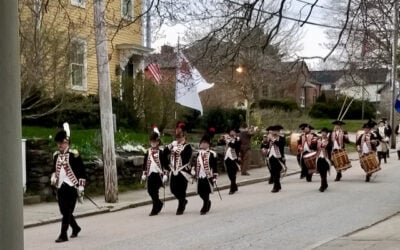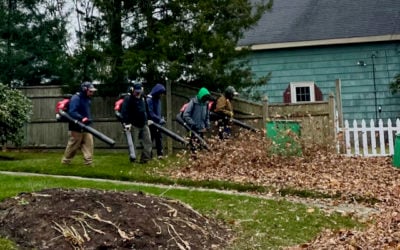By Tad Stoermer, Ph.D.
In the heart of East Greenwich, Varnum House stands as a portal to the past, offering a unique and tangible connection to the complex tapestry of our community’s – and our nation’s – history. The venerable structure is so much more than a building to be maintained, four walls and a roof to be propped up; the house, along with the entire property, is a dynamic platform for storytelling, capable of bridging time and space to immerse us in the pivotal choices and challenges of the American Revolution and founding era.
At their core, based on the latest research-driven data, we know that historic house museums hold a powerful, even unique, potential to be inclusive spaces where diverse narratives converge. Traditionally, such institutions have focused on the lives and achievements of relatively prominent figures, known locally for limited roles in major events, often sidelining the equally important stories of women, people of color, and other underrepresented groups, issues, and ideas. However, there’s an evolving recognition within the field of public history of the need to present a more holistic and inclusive narrative that reaches deep into every segment of our increasingly diverse community, connecting the issues that drove America’s founding to today’s headlines.
The Varnum House represents just such an opportunity. Its walls have witnessed not just the strategic discussions of military leaders, but also the daily lives of a young family struggling to meet the challenges of a new nation. Each room of the house offers a different perspective: the kitchen tells a tale of the women and others who toiled there, the study speaks of political and legal debates, while the property, as a whole, sheds light on the out-of-doors, lived experiences of all of the people who made the transformation from subjects of a king to citizens of a republic – even one that that did not, quite yet, recognize their place in it. Just as Varnum and his young wife Martha reflected such diverse stories in their own lives, as they began that life together, their house can challenge visitors to understand the complexities and contradictions of the past, and what that means for our present.
Moreover, in stark contrast to the misguided opinion of the Champlin Foundation, public historians and museum leaders across America understand that museums just like the Varnum House are uniquely positioned to engage a wide array of audiences. Through interactive engagement, immersive storytelling, and educational programs, they can captivate the imagination of young visitors, providing them with a tangible and relatable connection to history that goes beyond making connections to building lifetime relationships. For adults, these spaces offer deeper insights into the socio-political dynamics of the past, sparking ongoing conversations about our current societal and political structures and values.
The inclusivity of these narratives is not just an academic exercise; it’s a powerful tool for community building. By highlighting the multifaceted experiences of people who lived through the American founding era, the Varnum House can foster a sense of shared history. They remind us that history is not a monolithic narrative but a mosaic of human experiences, as dynamic then as they are today. Varnum and his wife lived that experience. Varnum, who challenged authority as a troubled Harvard student and was asked to leave the institution, turned that setback into a legal and political career that challenged the authority of a monarchy and then the authoritative presumptions of a people against freedom for the enslaved. As a soldier, Varnum succeeded, against considerable opposition, to forge the only path for enslaved men to gain freedom in young America through service to their country in establishing the 1st Rhode Island Regiment. Less well known is his political work as a member of the Continental Congress to ban slavery in the growing territories of the country – again representing the only successful attempt to do so when he helped pass a prohibition on slavery for a region that now covers five states, from Ohio to Minnesota. Those achievements alone make the space that he and Martha made of signal importance for exploring the central contradiction in American history.
Furthermore, in an era where the fabric of society is often strained by divisive narratives, the Varnum House offers a common ground. Contrary to what an armory or military history might offer, the Varnum House can provide a campus for dialogue and reflection, encouraging visitors – onsite and, increasingly, online – to consider different perspectives and cultivate empathy. The Varnum House can thus act as a catalyst for community cohesion and understanding.
However, realizing that potential requires a concerted, thoughtful effort. It calls for collaboration between public historians, educators, and East Greenwich leaders. Funding is, obviously, important in this endeavor, but a commitment to a strong vision might be even more critical. Fortunately, that energy already exists with Joanne Breslin and the rest of the current Varnum House team. Under their leadership, with community support, the Varnum House can emerge as a civic jewel in the crown of our town.
In conclusion, historic house museums are not just guardians of the past; they are active participants in shaping our understanding of history and its relevance to contemporary society. By embracing inclusive storytelling, institutions such as a recharged Varnum House can transform the way we view our collective past, making history a vibrant and engaging tool for education, reflection, and community building. In doing so, the Varnum House has the potential to not only preserve East Greenwich’s past but also enlighten our community’s present and guide our future.
Tad Stoermer, Ph.D., a lecturer in cultural heritage and museum studies at Johns Hopkins University and the film and digital media editor for The Public Historian journal, lives in East Greenwich. In 2021, he was named one of the “Top 50 Global Museum Influencers” by Blooloop.






 Subscribe
Subscribe
The house has generations of stories to tell. I am a descendant of the last family that lived in the majestic house. We must save this house! It makes no sense to destroy one history to preserve another history.
Well said
The Varnum House is part of what makes East Greenwich unique and special and adds to the character of the town. I remember my grandchildren going on their third grade tours of the house and how excited they were to tell the stories. It belongs to all generations.
I agree that the historic house is in a unique position to engage the public with educational programs and other events that could bring lesser known periods of Varnum’s productive, but all too short civic career to light.